
About UsThe Numismatic Bibliomania Society is a non-profit organization promoting numismatic literature. For more information please see our web site at coinbooks.org SubscriptionsThose wishing to become new E-Sylum subscribers (or wishing to Unsubscribe) can go to the following web page link MembershipThere is a membership application available on the web site Membership Application To join, print the application and return it with your check to the address printed on the application. Membership is only $15 to addresses in the U.S., $20 for First Class mail, and $25 elsewhere. For those without web access, write to: David M. Sundman, Treasurer AsylumFor Asylum mailing address changes and other membership questions, contact David at this email address: dsundman@LittletonCoin.com SubmissionsTo submit items for publication in The E-Sylum, just Reply to this message, or write to the Editor at this address: whomren@gmail.com
BUY THE BOOK BEFORE THE COIN |
- WAYNE'S WORDS: THE E-SYLUM DECEMBER 29, 2013
- EARLY U.S. SILVER ARTICLES IN LATEST ISSUE OF THE ASYLUM
- NEW BOOK: HISTORY OF VIET NAM MONEY
- NEW BOOK: THE LOVETT CENT; A CONFEDERATE STORY, 2ND EDITION
- BOOK REVIEW: CIVIL WAR STAMP ENVELOPES
- THOUGHTS ON THE SAMUEL HART PLAYING CARDS TOKENS
- STILL MORE ON THE WASHINGTON'S HEADQUARTERS COIN HOARD
- QUIZ ANSWER: CITY OF NEW ORLEANS
- NOTES FROM E-SYLUM READERS: DECEMBER 29, 2013
- ON STEAM PRESS ERA ADJUSTMENT MARKS
- MORE THOUGHTS ON FANTASY COINS
- THE 1965 CHURCHILL CROWN
- MORE ON USING THE SERIAL COMMA
- THE EARLIEST COIN DEALER PHONE NUMBER?
- CHICAGO COIN COMPANY COIN BAG AND COOKIE TIN
- OPTICAL ILLUSIONS ON COINS AND MEDALS
- NUMISMATIC VOCABULARY: ANAGLYPTOGRAPHY PART 2
- QUIZ ANSWER: RETROCESSION
- STILL MORE TURKEYS IN NUMISMATICS
- A DATABASE FOR TOPICAL COIN COLLECTORS
- QUERY: SANTA CLAUS ON A LARGE DENOMINATION U.S. BILL
- WHY YOUR DIGITAL WALLET BELONGS ON YOUR FINGER
- HOWARD DANIEL ON POLYMER BANKNOTES
- HOW TIGHT JEANS ALMOST RUINED AMERICA’S PAPER MONEY
- EDUCATIONAL TOUR PLANNED FOR HISTORIC MEDALS
- POSTCARDS AND NUMISMATICS: HAPPY NEW YEAR!
- FEATURED WEB SITE: THE E-SYLUM
Click here to access the complete archive
To comment or submit articles, reply to whomren@gmail.com
WAYNE'S WORDS: THE E-SYLUM DECEMBER 29, 2013

New subscribers this week include Adam Stump, Deputy Director, Office of Corporate Communications United States Mint; Kenneth Rowland, and Rai Arnold. Welcome aboard! We have 1,682 email subscribers, plus 259 followers on Facebook.
We're back! Thanks to Bruce Perdue for helping get the word out that this issue would be late. I was traveling with my family for the holiday and got held up for a good reason - the birth of a son to my wife's niece.
I had most of the issue ready to go before our trip, but the delay allowed me to add a number of new contributions, making this last issue of the year a whopper. I was unable to respond to everyone's email, but I should get caught up in the next few days. Happy New Year, everyone!
This week we open with a note on the latest Asylum issue, three new numismatic books, and a review of Fred Reed's book on Civil War Stamp Envelopes. Other topics include steam press era adjustment marks, the Churchill Crown, optical illusions on coins and medals, a proposed database for topical coin collectors, and did you hear I was drunk the day my ma got out of prison?
To learn more about retrocession, anaglyptography, the Samuel Hart playing cards tokens, the City of New Orleans, counterfeit numismatic books, and tight jeans, read on. Have a great week, everyone!
Wayne Homren
Editor, The E-Sylum
EARLY U.S. SILVER ARTICLES IN LATEST ISSUE OF THE ASYLUM
For those JR News readers who are not a member of the Numismatic Bibliomania Society (NBS), I’d like to point out that there are two good articles pertaining to early U.S. silver Numismatic Literature in the latest issue of The Asylum, the quarterly Journal of the NBS.
The first article is by Brad Karoleff and is titled, “Limited-Edition Silver Coin References: The Connoisseur’s Library Updated.” This article covers the deluxe editions of early silver references, half dimes to silver dollars, issued since and including the Haseltine Type Table sale catalog. Price ranges are given for deluxe editions from each series.
The second article is by Len Augsburger, and is titled, “Numismatic Literature for the Liberty Seated Half Dime Collector.” Steve Crain contributed to the section on the Valentine half dime book.
I am a former Treasurer of NBS, and am currently on the NBS Board of Governors. I recommend NBS membership to anyone with an interest in research and Numismatic Literature. Here is a link to the NBS website for those wishing to learn more or join NBS: http://www.coinbooks.com
The website has an online index of articles by subject and author. Four issues of The Asylum are published per year.
NEW BOOK: HISTORY OF VIET NAM MONEY
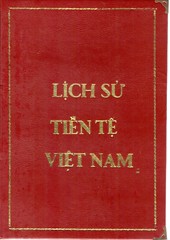 Lich Su Tien Te Viet Nam - 2013 First Edition, self-published,
Lich Su Tien Te Viet Nam - 2013 First Edition, self-published,
Ho Chi Minh City, Viet Nam
By Ha Van Tho (in Vietnamese)
8.5 x 11, 399 Pages, leather-like hardbound, full color
"Ho's book started with just illustrating and describing his collection but then he decided to greatly expand it with pieces from other collections and references. There are a few previously unpublished pieces. If you collect Vietnamese; French colonial; and Japan, Chinese, South Korea, Thailand and US military pieces used in Viet Nam, this will be a useful reference to you."
There is a representative collection of Imperial Viet Nam cash-style coins
A type set of French colonial coins and bank notes
A type set of Republic of Viet Nam, Democratic Republic of Viet Nam, and Socialist Republic of Viet Nam coins and notes
Some Republic of Viet Nam pattern notes, and one unissued Socialist Republic of Viet Nam note
Some non-circulating legal tender (NCLT) coins of the Socialist Republic of Viet Nam.
Some "trade dollar" coins and French colonial silver rounds
Some Socialist Republic of Viet Nam foreign exchange certificates, high denomination bank checks, and bonds
Some United States military club tokens from the Vietnam War era.
United States, Japan, Chinese, South Korean, and Thailand military related currency from WWII to the Vietnam War era
There are also pictures of Tho in front of many places in Viet Nam which are on many of the pieces.
Tho is a collector of pieces with "100" on them, and he will print only 100 copies of this reference.
NEW BOOK: THE LOVETT CENT; A CONFEDERATE STORY, 2ND EDITION
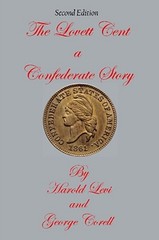 The Lovett Cent; a Confederate Story – 2nd Edition
The Lovett Cent; a Confederate Story – 2nd Edition
The 2nd edition of The Lovett Cent; a Confederate Story adds a new picture of Robert Lovett, Jr.’s grave with a plaque commemorating his induction into the ANA Hall of Fame and notes about two web sites containing collections of Lovett tokens and medals. Several photographs were updated to better images.
The primary focus of the 2nd edition is Robert Bashlow and the copies (2nd restrikes) he and David Laties made. Some of the deceptive fakes that have been in the marketplace have been identified with images and discussions. Several new images have been added with updated text. This includes information about the edge lettering on the Tin and Nickel pieces.
The British Confederate cents that Bashlow and Laties had made in London, England have been identified with photographs. This set was owned by John J. Ford, Jr. and is housed in a black leather case. The current owner of the set supplied photographs of the three coins. One is in gold, another in silver and the last was over-struck on an 1858 Flying Eagle cent. Images of additional specimens are also published in the book.
The Appendix has been expanded with additional information on Bashlow, which includes the complete set of Bashlow dies and hubs ensconced in the Smithsonian Institution. These images were supplied by the late Richard Doty, Ph.D.
The black and white version is in 6x9 inch format with a soft cover and is 388 pages. The price is $27 plus shipping from Lulu.com.
The color version is in 8.5x11 inch format with a hard cover and contains 310 pages. The coin and die images have been enlarges as much as possible in the larger format with text in two-columns. The price is $125 plus shipping from Lulu.com.
A PDF version is available for the Color version. This is $25 and can be downloaded from Lulu.com
To order the books, see:
The Lovett Cent; a Confederate Story (Paperback)
(www.lulu.com/shop/harold-levi-and-george-corell/the-lovett-cent-a-confederate-story/paperback/product-21164711.html)
The Lovett Cent; a Confederate Story (Color Hardcover)
(www.lulu.com/shop/harold-levi-and-george-corell/the-lovett-cent-a-confederate-story/hardcover/product-21164672.html)
The Lovett Cent; a Confederate Story (ebook)
(www.lulu.com/shop/harold-levi-and-george-corell/the-lovett-cent-a-confederate-story/ebook/product-21117824.html)
THE BOOK BAZARRE
BOOK REVIEW: CIVIL WAR STAMP ENVELOPES
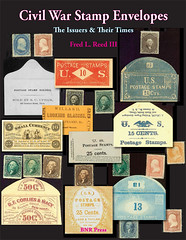 Civil War Stamp Envelopes – The Issuers & Their Times
Author Fred L. Reed lll, 2013, BNR Press, Port Clinton, Ohio, Foreword by Art Paradis, An Appreciation by Chester L. Krause, Reviewed by John and Nancy Wilson
Civil War Stamp Envelopes – The Issuers & Their Times
Author Fred L. Reed lll, 2013, BNR Press, Port Clinton, Ohio, Foreword by Art Paradis, An Appreciation by Chester L. Krause, Reviewed by John and Nancy Wilson
Fred L. Reed lll covers the subject of these envelopes in such an authoritative manner that nobody will have to look no further than this reference for information. Coming in at 4 pounds, we consider it a “Heavyweight Champion” of books. It is softcover, 8.5 x 11 inches and has 672 pages with about 1,500 black and white illustrations. The “Foreword” was done by Art Paradis, who over the last 13 years collected 213 different varieties of postage currency envelopes. Our interest in these envelopes started many years ago when we received a listing of these envelopes from Milwaukee, Wisconsin dealer, Kevin Foley, in the middle 1980s. We purchased several of the envelopes from this listing and over the years have added more. We collect by denomination type and are only lacking a few. Until the Foley listing, we rarely saw these envelopes for sale anywhere.
Hoarding of small change or specie in 1861-62 brought about by the Civil War caused havoc with merchants and businesses who were trying to conduct their daily business. A Law was passed on July 17, 1862, authorizing the gummed postage stamps to be used as money. Some innovative merchant came up with the idea to place postage stamps in an envelope with the amount posted on the outside.
Few have covered the civil war monetary system like Mr. Reed has. He divides the civil war monetary system into four sections. Part l will look at the federal and private Postage Currency. Part ll was encased stamps, which he covered in a separate book. Part lll covers, “A Numismatists Perspective of the Civil War series.” Part lV, will look at Civil War era counterfeiting.
The reference is dedicated to three luminaries of the hobby who are no longer with us, Art Kagin, Matt Rothert and Milt Friedberg. Milt did his own compilation of postage currency envelopes for the Fractional Currency Collectors Board (FCCB) in June, 1986. Milt’s catalog was distributed to the membership of the FCCB and is rarely available in the market place. The “An Appreciation” by renowned numismatist Chester L. Krause explains how the six different types were produced. He describes how his interest started about three decades ago and his purchase of three envelopes for $30 each. Chet mentioned his collection contained over 150 different envelopes which were sold over several sales in recent years. The Ford collection (sold in 2007) had 141 pieces and the Western Reserve Smythe 2007 sale had 42 examples. Through Chet’s collection, Krause Publication published in its Standard Catalog of United States Paper Money a listing and pricing of the envelopes.
The “Preface” includes the authors’ thoughts on U. S. postage stamps as necessity war money. He also describes the denominations he has found along with their rarity. There are 90 separate issues of different designs. The preface also has a reprint of the Henry Russell Drowne article that was in the American Journal of Numismatics in 1918. Thomas Cunningham is quoted in this article, “that even in 1893 he had never seen one of these envelopes.” Reed shows copies of reprinted envelopes which were published in newspapers along with ads for them. He also describes U. S. postage currency that came into circulation at about the same time that the envelopes appeared. The author reprints the front page of the 1865 Charles Moreau pamphlet (only ten known) which listed the envelopes.
Fred explains that because of a few collectors back in the issuing years some of the envelopes were saved. He mentions that almost all of the envelopes known today come from ten hoards “dating back to David Proskey, Charles C. Moreau, and others who assembled their collection of these ephemeral pieces during the Civil War era.” He has identified 500 plus varieties of these envelopes. Besides listing the varieties the author gives information on the issuer, shows illustrations of their work and finally, “provides their context – by also giving their merchant-issuers’ background information.” He also gives the important information on the 128 identified issuers along with how many different varieties are known for each denomination. Reed discusses the under-appreciation of these envelopes in the collecting community and how “flat out rare” they are. Reed lists his rarity scale from R-10 Unique to R-1 100+. You will find a rarity for all the postage currency envelopes listed in this reference.
The “Civil War Postage Stamp Envelope Timeline” starts on July 4, 1862 with the William Newton, Newport, RI stamp scrip notes which were issued in denominations from 5 to 50-cents. The Timeline ends in October, 2013. This timeline covers everything that would be related to postage stamp envelopes, along with Laws, Patents, Post Office recommendations, collectors & dealers, auction and fixed price lists, the issuers, newspaper and hobby publication articles, donations to institutions, as well as important events or dates.
The next 31 pages cover, “Prior Cataloging Efforts/Famous Collections.” This covers everybody who had anything to do with this type of substitute money. The author tells us Henry Russell Drowne was a fractional currency collector and his, “Ground-breaking article on Civil War Stamp envelopes has been an essential authority for collectors and catalogers for nearly the past century.” Another collector was Deats who was Charter Member No.15 of the American Numismatic Association and owned the “very rare 1822 half eagle (3 known).” Reed tells stories and has photos of: F. C. C. Boyd, David Proskey, Norman Stack, Herman Crofoot, Matt Rothert, Abe Kosoff, Dr. Richard Doty, Charles J. Affleck, Milt Friedberg, Kevin Foley, Ezra Cole, John J. Ford Jr, Chet Krause, David Bowers, Ray Waltz, Peter Huntoon, Art Paradis and several others.
Fred Reed lists all the known U.S. postage currency envelopes in alphabetical order by state. There are 128 issuers and 514 different varieties produced by them. Almost all varieties are illustrated and extensive census and provenance data is given, along with auction prices realized for these scarce monetary instruments over the last century of their active collecting.” In this book he uses the same catalog numbers he gave to Arthur and Ira Friedberg for their 19th and 20th Editions for Paper Money of the United States.
Illinois was the first state to issue postage currency envelopes and only one example is known. The issuer was McNall & Co. from Chicago. The author covers this merchant very thoroughly and all we have to do now is find one of the envelopes he produced. Like Illinois, Maine has only one example known and it is listed as R-10 Unique. The issuer was J. W. Cofren who was a pharmacist from Augusta, Maine. Information regarding Mr. Cofren will be found on the page along with a reprint of an 1855 ad which was in the Maine Register.
Only one R-10 Unique example is listed from Baltimore, Maryland. Ten issuers are listed from Massachusetts and most are very rare. Seven come from Boston, one from New Bedford & Boston, and one each from Salem and Springfield. For a state type set you should be able to get one from Boston merchant Snow & Hapgood. Snow & Hapgood produced a Civil War patriotic envelope. Also shown is an illustration of a fractional currency wallet that has straps holding fractional notes.
New Jersey has two issuers and both are rare. Fred Reed shows some of the advertising pieces he has found on the New Jersey’s Taylor’ Hotel showing up on Ebay, which included an 1880 four-page advertising brochure for the hotel along with other items. The author mentions that unfortunately he wasn’t successful for this lot or all would have been illustrated. Think of the thousands of numismatic items Mr. Reed writes about regarding the Civil War or Lincoln and the time it takes to find the information? It is mind-boggling the amount of time he spends on his research and books.
New York has 108 different issuers and the book is full of great information on all of them. It appears that some of the information he is writing about would only be possible if you lived during the Civil War. John Campion Force, or Johnnie Force as his friends called him, was an extraordinary restaurateur, bar keeper, hotel owner, sportsman and art love in Brooklyn, New York, who advertised his National Shades Chop House on postage stamp envelopes during the Civil war.
The author then talks about Mr. Force like he is right in the business talking to him and or his friends. Ohio (Cincinnati) only had one issuer, (Oscar H. Harpel), (R-9, 2 known) who issued 5 and 20 cent envelopes. A photo of Oscar Harpel says he “was a song writer, an innovative printer, author and illustrator/painter.” A letter head and other ephemeral items are illustrated. Four issuers will be found from Pennsylvania (Philadelphia) and all are rare. Issuer E. M. Riggin issued a 50 cent envelope which is listed as R-10 Unique.
Another issuer, S. C. Upham, issued two envelopes with no denomination on them. Mr. Upham is well known as an issuer of Confederate currency replicas. Numismaster - Krause Publications has great information on Mr. Upham. The article was done by Fred Reed for Coins Magazine in 2008, and can be found at: www.numismaster.com/ta/numis/Article.jsp?ad=article&ArticleId=3813. Rhode Island only had one Issuer, L. C. Munn from Providence.
Anonymous issues follow and maybe you can lend your knowledge by providing the author the name of the merchant, city or the state of the 17 pages of postage stamp envelopes listed. Appendix A has the “Reed Cataloging System for stamp envelopes at a glance.” All the issuers are listed alphabetically in this section and not by state. The “Annotated Select Bibliography” covers 26 pages and gives an idea of the work that went into this reference.
As collectors of these envelopes, we have already numbered the examples in our collection. We now have the definitive reference on the envelopes and can study them in a knowledgeable manner. This “Heavyweight Champion” of references is well worth the price of $59.95 softcover or $95 hardcover (not Smyth-sewn). Postage, handling and insurance per book is $10. It is available from BNR Press, 132 East Second Street, Port Clinton, OH. 43452-1115 or call (419) 732-6683.
THOUGHTS ON THE SAMUEL HART PLAYING CARDS TOKENS
Some Thoughts About the Samuel Hart Playing Cards Tokens
For those who are playing card aficionados, Samuel Hart is a legend in the evolution of the American playing card. Hart is credited with incorporating many advancements and innovations that have become de facto standard features of playing cards available throughout the world.
Those individuals who are interested in exploring Merchant Tokens may want to consider acquiring a few of the Samuel Hart's playing card tokens. The tokens were struck in 1850s and 1860s, and were beautifully fashioned.
There are three major varieties of the Samuel Hart playing card tokens. Two of the three major varieties are quite prolific, and are easily obtainable. Nice, high-grade examples can be had for less than $100 each.

The PA-197A and B varieties are 29mm in diameter and feature the Queen of Diamonds and Jack of Clubs. They were struck in copper and white metal respectively. The white metal variety (197B) is the least encountered variety, but high-grade examples can still be found.
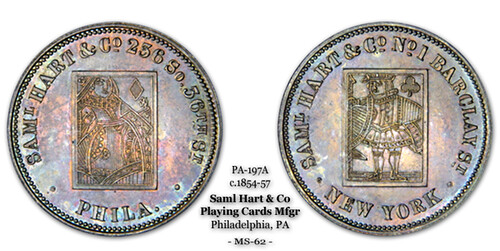
The PA 195, 195A, 196, and 196A varieties are 25mm in diameter and feature a griffin's head on the obverse. Of these, the least encountered is the PA-185A struck in copper.
Pictured below are two of the PA-195 varieties in silvered brass. While they are regularly seen in various numismatic marketplaces, most often the silvering is incomplete or worn in places.
The first is typical of the silvered variety. Partial silvering is apparent.

The second is atypical of the silvered variety. Its silvering is 100%.

The third and final major variety comprises those that were struck in hard rubber/vulcanite. This series is rarely encountered and can be quite expensive to add to one's cabinet.
I have seen but only two examples in person. David Schenkman, author of the authoritative guide of Hard Rubber Tokens, has only himself seen a few more. Unlike the aforementioned varieties, for those interested in acquiring an example, my advice is to not wait when one becomes available. Be prepared to pay about $800-1000.
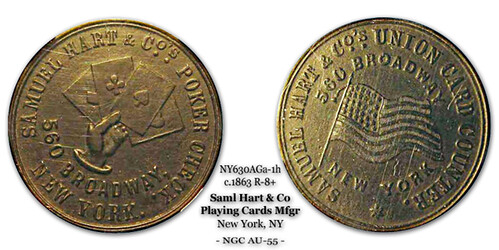
For those who decide to pursue acquiring examples these tokens, I recommend exercising some patience. With time, beautiful examples can be obtained without investing too much.
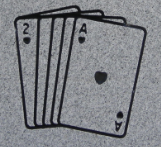 Thanks for a great article about some interesting tokens, On a personal note, I thought I'd add that my mother loved playing card games of all types, and my sister and I had some included on her headstone in Allegheny Cemetery in Pittsburgh,
-Editor
Thanks for a great article about some interesting tokens, On a personal note, I thought I'd add that my mother loved playing card games of all types, and my sister and I had some included on her headstone in Allegheny Cemetery in Pittsburgh,
-Editor
STILL MORE ON THE WASHINGTON'S HEADQUARTERS COIN HOARD
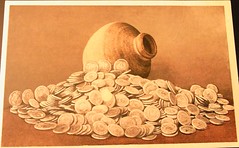 The New Windsor, NY (1869) coin hoard, consisting mostly of Spanish pillar dollars (8 reales), is listed in my Numismatic Finds of the Americas under number 385, with a date of deposit of 1777 (the assumption was that it had some connection with the military movements at the time of the Saratoga campaign; another argument in favor of the 1777 date is that there are no Carolus bust dollars reported from the hoard).
The New Windsor, NY (1869) coin hoard, consisting mostly of Spanish pillar dollars (8 reales), is listed in my Numismatic Finds of the Americas under number 385, with a date of deposit of 1777 (the assumption was that it had some connection with the military movements at the time of the Saratoga campaign; another argument in favor of the 1777 date is that there are no Carolus bust dollars reported from the hoard).
As listed in the entry, the contents are 652 silver coins, 1 gold medal. The silver coins are 8 reales, dating from 1621 through 1773, and a French écu, dated 1734. There was a gold medal “struck in honor of some Spaniard, dated 1654.” It was found on the estate of Thomas Ellison by Silas Corwin. The mansion is said to have once been the headquarters of General Washington. The jar was found four feet below the surface. Its open end was downward, and it rested on a flat stone.
The Corwin family sold most of the coins for large prices, but retained some as curiosities. Some are supposed to have gone to the State Museum of Newburgh, New York. One coin went to Dr. Goodrich, the State Treasurer of Connecticut, according to the Hartford Times.
The citations I give are an article by Reginald Pelham Bolton in the Quarterly Journal of the New York Historical Society (January 1931), pp. 112, 117 (if I remember rightly this is just a reproduction of the postcard); Sydney Phillip Noe, The Castine Deposit (1942) p. 34; Walter Breen, "Survey of American Coin Hoards", The Numismatist, January 1952, p. 9 (Hoard number III); I. D. Brown and Michael Dolley, A Bibliography of Coin Hoards of Great Britain and Ireland, 1500-1967 (1971) p. 59 (Hoard number NT1)(just a short listing), and two mentions in the American Journal of Numismatics: vol. 18, no. 4, p. 79, and vol. 20, no. 4, p. 92.
There are some contradictions here with the subsequent information: Was the hoard found by Silas Corwin or by Samuel Pink? The last two digits of the date of oldest coin were transposed in one account, so is the date 1612 or 1621? 1612 or 1621 would be a cob, not a pillar dollar, which is interesting. If the deposition occurred in connection with the headquarters of Washington/Knox, then 1782 might be a more probable date of deposit. But if 1782, why no Carolus bust dollars? Was the hoard put together by someone picking out the pillar dollars (917 fine) at a time when the Carolus bust dollars (903 fine) first began to circulate?
It would be good if photographs of the obverses and reverses and weights of the approximately 32 coins that are in the State Museum could be published; just knowing the dates and mintmarks would be useful. It would also be helpful to have good photographs of the jar (if it, too, has survived), to compare it to a reference work such as Kathleen Deagan, Artifacts of the Spanish Colonies and the Caribbean, 1500-1800, vol. 1: Ceramics, Glassware, and Beads (1987).
To read the earlier E-Sylum article, see: MORE ON THE WASHINGTON'S HEADQUARTERS COIN HOARD (www.coinbooks.org/esylum_v16n52a13.html)
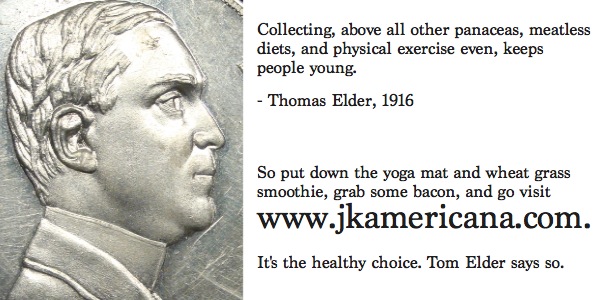
QUIZ ANSWER: CITY OF NEW ORLEANS
First to respond was our webmaster, Bruce Perdue, and he had the correct answer.: The song "City of New Orleans". The line is "the train pulls out of Kankakee." Howard Berlin knew this one, too. Other readers filled in more details.
Tom DeLorey writes:
"City of New Orleans."
"...along the southbound odyssey, the train pulls out of Kankakee...."
My first wife and I lived on the south edge of Chicago, and occasionally would take a Sunday drive down Illinois Highway-1 to Kankakee for lunch. The highway parallels the Illinois Central tracks for quite a while, and occasionally we would see Amtrak's "City of New Orleans" heading towards Chicago.
Pablo Hoffman writes:
"All along the south-bound odyssey The train pulls out at Kankakee... "
N'awleans, here we come.
John Dannreuther writes:
Easy. "City of New Orleans". Goes by my house at either 5:45 or 6:45, depending on the season. Usually, right on time!
City of Chicago comes by at either 10:45 or 11:45. Never seems to be far off, either.
Now, most will think Arlo Guthrie wrote the song. How many know who wrote it?
Next week's question should be how many numismatists were/are musicians. I can think of quite a few.
John gets extra credit for knowing the songwriter. He knew the answer to that question of course, as did Bill Eckberg, who writes:
City of New Orleans.
Written by Steve Goodman in 1971.
Hit for Arlo Guthrie in 1972.
Goodman's tune was an instant classic - pure poetry, even for people who wouldn't be caught dead reading a poem. Other artists have covered it, too. Jerry Schaeper writes:
When I read the quiz the first artist I thought of was Hank Snow's version of THE CITY OF NEW ORLEANS. Arlo Guthrie's 1972 version of it is probably what most folks better recall. Also recorded by Johnny Cash and others.
Dave Schenkman writes:
The song was written by Steve Goodman, a songwriter who died at an early age. He wrote a lot of neat songs. “City” was popularized by Arlo Guthrie. One of my favorite versions was recorded by the Seldom Scene, a bluegrass group that has been a fixture in the Washington, DC area for decades. The singer, at the time, was John Starling, a physician that the mandolin player referred to as “an ear, nose and wallet specialist.”
From folkblues.com:
In 1970, Steve wrote a song which would eventually be called by many people "the best train song ever written." Steve pitched the song to Arlo Guthrie, and in 1972, Arlo included the song on his album Hobo's Lullaby. It was then released as a single and became a big-time hit record. Steve always thanked Arlo for recording the song, and for making it possible for Steve to do what he loved -- playing music for a living.
ABC News' morning show, Good Morning America, which started in the mid-70's, took its name and its original theme from the chorus of City of New Orleans.
That site has the original Steve Goodman lyrics: City of New Orleans (www.folkblues.com/goodman/cono.htm)
Here's a link to the Arlo Guthrie lyrics: Arlo Guthrie – The City Of New Orleans Lyrics (www.lyricsfreak.com/a/arlo+guthrie/city+of+new+orleans_20178738.html)
John Mutch provided the following YouTube link and commented:
A long-time favorite!
www.youtube.com/watch?v=OfxoM6trtZE
Regarding Steve Goodman, Bill Eckberg adds:
He also wrote "the perfect country and western song," You Never Even Called Me By My Name.
In one verse, he covers mama, trains, trucks, prison and getting drunk:
I was drunk the day my ma got out of prison
And I went to pick her up in the rain.
But before I could get to the station in my pickup truck,
She got run over by a damned old train.
If she'd been run over by a reindeer it could've been a Christmas song, too. Thanks for playing, everyone!
Maybe there's a numismatic connection after all. How about... ?
"Dealin' card games with the old men in the club car
Penny a point, ain't no one keepin' score"
I would encourage our younger readers (many of whom weren't even BORN yet in 1972) to get a copy of the Guthrie version from iTunes - I think the studio version is better than the live video.
There are many great lines in this song, and one that resonates with me is:
"And the sons of Pullman Porters, and the sons of Engineers
Ride their father's magic carpets made of steel"
The railroads were the result of a generation's labor and ingenuity. They brought the nation together, and spawned the modern corporation, standard time zones, and more. But by 1972 passenger service had dwindled to a shadow of its former self. Even its replacement, the passenger car, was getting long in the tooth, as signified by "the graveyards of the rusted automobile."
The railroads were made efficient through the use of another invention, the telegraph. To me, Morse's telegraph is the magic carpet we're all riding today. Its dots and dashes were the digital system of its day, and the first transatlantic telegraph cables were the world's original Internet. The telephone system was a diversion into the analog world, but today we're back to digital and connected in more ways than could ever have been imagined. Text, voice, sound and sight are all carried effortlessly along today's digital pipes. Fiber optic cables snake thorough the same underground Manhattan vaults that once held telegraph cables; this issue of The E-Sylum may travel to our London readers along the same Nova Scotia to Dublin route of the first telegraph cable.
The E-Sylum is getting a little long in the tooth itself. We have more users than ever thankfully, but dialup modems and desktop computers are already in the dustbin of technology history. Facebook, Twittter and a thousand smartphone apps are replacing email. But old technology rarely goes away completely - it just adapts to its niche and carries on. The City of New Orleans is still making that southbound odyssey, and The E-Sylum is still here. If we've been made obsolete, I guess we "still ain't heard the news."
To read the earlier E-Sylum article, see: NOTES FROM E-SYLUM READERS: DECEMBER 22, 2013 : Bob Leuver on The E-Sylum, Bitcoins, and Jesse Owens (www.coinbooks.org/esylum_v16n52a08.html)
NOTES FROM E-SYLUM READERS: DECEMBER 29, 2013
You Should Always See The Coin Regarding Bob Van Arsdell's submission titled "Sometimes You Have To See The Coin", Tony Terranova writes:
I think you should ALWAYS see the coin.
To read the earlier E-Sylum article, see: SOMETIMES YOU HAVE TO SEE THE COIN (www.coinbooks.org/esylum_v16n52a10.html)
Hartzog Limited Edition Catalogs Rich Hartzog writes:
For the record, as a auctioneer of exonumia I have published some 11 formal mail bid sale catalogs. On some of the early catalogs, I produced limited editions with the buyer's name in calligraphy on a special insert sheet as the first page after the cover. Generally only a few were issued, perhaps 4 to 6 copies. I neglected to retain any, or the numbers issued. These were in the early stapled catalogs. I went to perfect-bound catalogs in later years, and it was not possible to add a page.
To read the earlier E-Sylum article, see: SPECIAL EDITION NUMISMATIC AUCTION CATALOGS (www.coinbooks.org/esylum_v16n52a05.html)
Howard Gibbs and Football Player Johnny Unitas Regarding Pittsburgh numismatist Howard Gibbs, Richard Margolis writes:
How many practicing numismatists can boast of having dinner cooked for them by Johnny Unitas's mother?
Sara and I can. . . in the winter of 1959 we drove to Howard's house in Pittsburgh, in order to partially purchase and partially receive on consignment from him a valuable group of foreign coins. Dinner was cooked for us by Mrs. Gibbs, who was none other than Johnny Unitas's mother.
My clearest recollection of that evening, some fifty-four years later, is the superb meal she prepared.
I have often wondered how Howard, who was thin as a rail, was able to maintain his weight under the daily barrage of such great cooking.
To read the earlier E-Sylum article, see: NOTES FROM E-SYLUM READERS: DECEMBER 22, 2013 : Howard Gibbs in Egypt (www.coinbooks.org/esylum_v16n52a08.html)
Correction: Art Paper In last week's announcement of Pabitra Saha's new book on current coins of the world, this sentence should read as follows:
The book is printed on high quality art paper
Sorry I messed that up; he sent me a correction prior to publication, but it fell through the cracks. We'll update our archive, too.
To read the earlier E-Sylum article, see: NEW BOOK: HANDBOOK OF CURRENT CIRCULATING COINS OF THE WORLD (www.coinbooks.org/esylum_v16n52a03.html)
On Counterfeit Numismatic Books
Gordon Frost discovered a pirated edition of the Red Book, produced somewhere in the Far East. I believe he sold it to Armand Champa and that it was auctioned as part of Champa’s collection. Of course in this case the fake is scarcer and more desirable than the original!
To read the earlier E-Sylum article, see: NOTES FROM E-SYLUM READERS: DECEMBER 22, 2013 : Query: Are There Fake Numismatic Books? (www.coinbooks.org/esylum_v16n52a08.html)
Sulphur Centennial Misspelling
 Eagle-eyed reader George Huber writes:
Eagle-eyed reader George Huber writes:
I wonder if the Sulphur coins with the Centenial misspelling will command the same premiums as the Lesus coins?
To read the earlier E-Sylum articles, see:
SULPHUR, LOUISIANA'S CENTENNIAL MEDAL
(www.coinbooks.org/esylum_v16n52a17.html)
VATICAN MEDAL MISSPELLS NAME OF JESUS
(www.coinbooks.org/esylum_v16n42a24.html)
The Archaeology of Beer Kavan Ratnatunga writes:
Here's a new line of Archaeological research worth testing on our ancient pots. Season's Greetings and wish you all the best for 2014.
Starting with a few porous clay shards or tiny bits of resin-like residue from a bronze cup, McGovern is able to determine what some ancient Norseman or Etruscan or Shang dynast was drinking as he kicked back thousands of years ago. From a cardboard box, McGovern pulls out several plastic bags containing ancient pottery shards from China. It was from these that he identified the world’s oldest known fermented beverage, dating to about 7000 B.C.—a few centuries after humans began transitioning from hunter-gatherers to farmers. From another box, he pulls out shards and residues collected from four Scandinavian settlements, dating to between 1200 B.C. and 200 A.D. All of them contained traces of an essentially identical beverage, suggesting a drink—McGovern dubbed it “Nordic grog”—that was popular across Scandinavia for more than a millennium.
Details will appear in a forthcoming issue of the Danish Journal of Archaeology. But if your curiosity is more immediate and tends toward the gustatory, head to a nearby wine-and-beer store and request a bottle of the most recent Ancient Ale from Dogfish Head. The Delaware-based brewery launched its Ancient Ale Series in 1997, and in 1999 collaborated with McGovern to make Midas Touch, a brew that was inspired by the residue found on pottery fragments in a 2,700-year-old tomb in Turkey.
To read the complete article, see: The Archaeology of Beer (www.theatlantic.com/magazine/archive/2014/01/the-archaeology-of-beer/355732/)
Scoring Big With Physical Bitcoins Regarding physical Bitcoins, I wondered if any of our readers add one of these to their collection before the Bitcoin price skyrocketed. Ben Keele writes:
Some time ago I purchased two of these Cassius physical 1-Bitcoins. At the time, a Bitcoin unit was about $3, so I spent a bit over $6 since I was paying for the manufacture of the tokens and shipping. To redeem the Bitcoin codes and use the funds digitally, one must remove a holographic sticker from one side of the token. I planned to never remove the sticker and thus keep my tokens in "mint" condition.
However, after a while Bitcoin went up to around $40 a unit, and I couldn't resist making a little profit. I peeled off the hologram and exchanged the digital Bitcoin for around $80 cash. As I write this email, Bitcoin is over $700 a unit, and was over $1,000 a month or so ago, so it appears I timed the market very poorly! My wife and I joke that if I had invested all our retirement savings in Bitcoin at $3 and sold at $1,000, we'd be on our way to a very nice retirement. However, I probably would have given myself an ulcer obsessing over the Bitcoin market and deciding when to sell!
I still have the tokens and stickers--in addition to giving me a decent story, they remind me I shouldn't invest much in such volatile goods.
Items like these should be collected for our national museums, too. I would add to my recommendation that anyone purchasing such items for their own collections purchase some duplicates as well. Someday they could be sold or donated to repositories such as the National Numismatic Collection, the American Numismatic Association, and the American Numismatic Society. -Editor
To read the earlier E-Sylum article, see: U.S. GOVERNMENT SHUTS DOWN PHYSICAL BITCOIN MINTER (www.coinbooks.org/esylum_v16n51a14.html)
Query: Wesley Cox Contact Information Sought
ON STEAM PRESS ERA ADJUSTMENT MARKS

Planchet adjusters at the Philadelphia Mint, 1852
Alan V. Weinberg writes:
I noticed the image in the last E-Sylum depicting women engaged in planchet weight adjusting using files at the US Mint in 1852. I have never seen adjustment marks on any US coinage after the steam press was used in 1837. Is it true that they were still hand-adjusting planchets at the Mint as late as the pre-Civil War years?
Alan writes:
I would think we'd still see adjustment mark traces in the blank fields and in the blank areas of the shields' bars. After all, we do often see planchet "drift marks" , grease streaks and laminations on such post-1837 coinage which don't disappear or even start to dissipate under the pressure of a steam press. About three years ago Legend offered a Gem Proof Barber half dollar for sale on their website with "adjustment marks" visible on the Barber Liberty Head cheek ! I emailed them that adjustment marks on such a late coin were impossible and never received a reply.
Roger writes:
All gold coin blanks and planchets were adjusted by filing or shaving, as were silver coin blanks for quarters and larger denominations. Improvements in rolling mills and cutting machines between 1836 and 1840 by Franklin Peale, and Mint balances by Joseph Saxton and Peale, resulted in much more uniform blanks and planchets. At this time, all face filing of blanks was abandoned in favor of edge filing. The 1852 illustration depicts adjusters engaged in this operation. This practice ended only with cessation of gold coinage in 1933, and silver during WW-II due to labor shortages.
As a practical matter, the deformation of planchets during striking obliterated most face adjustment marks and all edge adjustment marks. Most surface striations on later 19th century coins resulted from rolling and drawbench manipulations combined with incomplete filling of the die.
[Sources: Journal of Numismatic Research, Spring 2013; the book From Mine to Mint includes extensive descriptions of adjusters and how they did their work.]
To read the earlier E-Sylum article, see: REVIEW: JOURNAL OF NUMISMATIC RESEARCH, SPRING 2013 (www.coinbooks.org/esylum_v16n52a06.html)
MORE THOUGHTS ON FANTASY COINS
Last week, speaking of the Confederate Cents, Bill Eckberg wrote:
... let's just call these fantasy pieces.
I added:
Not that there's anything wrong with fantasy pieces - there are the 1913 Liberty Nickels and the Fantastic 1804 dollars, of course. All fantasies, yet avidly collected and sought after for both their rarity and notoriety
Leon Saryan writes:
I think there is something wrong. The 1913 nickel and the 1804 silver dollar are clearly two of the highest priced and most storied "coins" in American numismatics. However, I personally believe that it is embarrassing for the hobby that we have hitched our horse to a couple of pieces that are nothing more than fantasy concoctions. Uninitiated outsiders must wonder why we are promoting items that are not true coins to the pinnacle of our pursuit.
John Dannreuther writes:
The Confederate cents may be fantasies, but the 1804 dollar should not be called such, in my opinion. They were struck by the US Mint in 1834, just dated 1804. You can call them novodels or whatever, but they are not fantasies, as I understand the term.
The 1913 nickel issue is a fantasy, I guess, but I call that one a clandestine issue, as it was from Mint dies, just struck in secrecy, like the 1884 and 1885 Trade dollars (thank you, A. Loudon Snowden for these two Trade dollars and for not melting the two Half Unions!).
Mark Van Winkle writes:
I refer Bill Eckberg to the study of all things CSA cent-related in The Lovett Cent, a Confederate Story (2006), by Harold Levi and George Corell. The original strikes are definitely not fantasy pieces.
Harold Levi wrote:
I agree with Bill Eckberg that technically the Confederate cent is a fantasy. At this time, there are no known Confederate records directly mentioning the Confederate cent made by Robert Lovett, Jr. This is not to say that none exist or never existed. A large volume of Confederate records were burned by officials when Richmond was evacuated in 1865 and Juda P. Benjamin (CSA Secretary of State) burned all of the records he had.
In response to Bill's latest comment, Harold Levi writes:
It is not my purpose to debate or sell Bill Eckberg, or anyone else, on the legitimacy of the Confederate cent, but to present some evidence that the Confederate cent was struck in 1861.
The Confederate cent, like many other coins, does not have a clean pedigree. As with other coins in this category, many stories have been conjured up to add mystery and intrigue to get a higher price at auction. It is up to each collector to look at the evidence and stories and then decide for themselves what to believe or not believe. In my book, The Lovett Cent; a Confederate Story, with assistance by George Corell, several logical arguments are presented to support the manufacture date of 1861. The strongest single forensic argument is the publication of a photograph of an original Confederate cent in 1875. By the way, the second edition of the book has been published.
In 1875, Dr. William Lee published his study of Confederate notes. The title is: The Currency of the Confederate States of America. A Description of the Various Notes, Their Dates of Issue, Varieties, Series, Sub-Series, Letters, Numbers, etc.; Accompanied With Photographs of the Distinct Varieties of Each Issue. Compiled From Official Records and Other Sources. On page 27 is a photograph of an original Confederate cent and the text he wrote, which is a repeat of part of John Haseltine’s auction description from January 1874.
The attached image was scanned by personnel at the American Numismatic Society in New York City from their copy of Dr. Lee’s book. As you can see, the toning is somewhat splotchy, or mottled, and tends to be around the edge of the coin, both obverse and reverse. This toning pattern matches the style of toning on other known original Confederate cents. If this coin was struck in 1873, as some suggest, the toning should not have been as advanced as it was in two years.
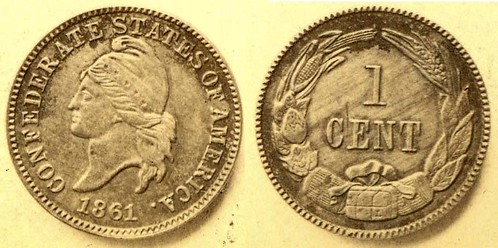
To read the earlier E-Sylum articles, see:
MORE ON THE LOVETT CONFEDERATE CENT
(www.coinbooks.org/esylum_v14n28a09.html)
NOTES FROM E-SYLUM READERS: DECEMBER 22, 2013 : The Fantastic Confederate Cents
(www.coinbooks.org/esylum_v16n52a08.html)
THE BOOK BAZARRE
THE 1965 CHURCHILL CROWN
The Churchill Crown really is a "love it or hate it" item - I don't think I know any collector who's a fence-sitter on this one. I may be in the minority but I'm in the "love it" camp - the Churchill effigy is realistic (much more than can be said for a lot of modern portraiture) and seems to grow out of the field of the coin, almost as if it were an unfinished statue. The one word on the reverse is all that needs to be said. Sure, there were too many made, but that at least means they have not been priced out of the market and anyone who wants one will never be disappointed. It doesn't worry me that it's only "worth" 25 pence still, it will stay on my list of favourites. Collectors don't have to be investors.
I'd also add that it was the only British commemorative coin that year, indeed the only one between the crown piece of 1960 and that of 1972. So in the meantime we've gone from a small number of commemorative issues, each with large mintages, to a huge number of issues each year but usually much smaller individual mintages. I know which I prefer from this perspective, too, and would vote for "anything after about 1990" as "worst commemorative" on that basis alone, not just from the UK.
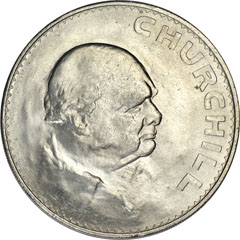 The Great Britain 1965 Winston Churchill crown was the first time a commoner was portrayed on a British coin.
The Great Britain 1965 Winston Churchill crown was the first time a commoner was portrayed on a British coin.
With so many commemorative coins issued in recent decades, it’s hard to imagine that at one time being portrayed on a commemorative coin was one of the highest honors for any individual. The appearance of Churchill shows the magnitude of his importance and popularity.
Churchill graduated from the Royal Military Academy in Sandhurst at the end of 1894 and saw action in British India, Sudan and the second Boer War in South Africa. He later went into politics and served as Chancellor of the Exchequer where he returned the British Pound to the gold standard in 1925. In 1940 he became Prime Minster after Neville Chamberlain resigned. During this period he reached his highest acclaim by leading Great Britain through World War II and to victory.
Churchill received many awards and honors including the Nobel Prize for Literature and the offer of Duke of London, which he refused. He was the first person made an honorary citizen of the United States and one of only seven to receive this honor.
After his death in January 1965 at the age of 90, he received some of the greatest honors. By decree of Queen Elizabeth his body laid in state for three days. The queen attended his funeral at St. Paul’s Cathedral, which was almost unheard of for a monarch.
Portraits on coinage were reserved for the ruling monarchy in Great Britain. Yet, the magnitude of Winston Churchill and the imprint he had left on Britain (and the world) was too great to resist. As the world quickly paid its respects, Britain issued a circulation coin like none other in its history.
To read the complete article, see: WORLD COINS: GREAT BRITIAN 1965 WINSTON CHURCHILL CROWN (www.ngccoin.com/news/viewarticle.aspx?NewsletterNewsArticleID=1284)
To read the earlier E-Sylum article, see: THE ONS' BEST AND WORST IN NUMISMATICS (www.coinbooks.org/esylum_v16n52a22.html)
MORE ON USING THE SERIAL COMMA
Martin Purdy writes:
Regarding the "Oxford comma", since we're talking about the Oxford Numismatic Society's list - rules are good but sometimes they need to be handled flexibly when the sense demands it, or when sticking too firmly to them might result in ambiguity. The examples you quote cover the ground nicely - I like what happens to this sentence when you drop the comma:
She took a photograph of her parents, the president, and the vice president.
She took a photograph of her parents, the president and the vice president.
The first sentence tells me there are four people in the photo. The second sentence only two, her parents being the officials in question.
Thanks for another great year of newsletters - all the best for 2014!
Pablo Hoffman writes:
May I call your attention to perhaps the most entertaining book on punctuation ever written, Eats, Shoots & Leaves: The Zero Tolerance Approach to Punctuation, by Lynne Truss.
Amanda DeWees
I’m an editor at Whitman Publishing, where we firmly believe in the rightness of the serial comma. Whitman’s house style largely follows the recommendations of the Chicago Manual of Style—now in its 15th edition, which appeared in 2003—because the comma prevents such ambiguous statements as this:
“I would like to thank my parents, Gandhi and Mother Teresa.”
Are the speaker’s parents in fact Gandhi and Mother Teresa? Without the serial comma, there is room for confusion.
Don Kolman noted that he would have to have an English PhD tell him to use the serial comma. Well, I’m an English PhD—and I’m saying that everyone should use it!
To read the earlier E-Sylum article, see: ON USING THE SERIAL COMMA (www.coinbooks.org/esylum_v16n52a09.html)

THE EARLIEST COIN DEALER PHONE NUMBER?
Kay Olson Freeman writes:
Most businesses used telephone numbers in their advertisements and directory listings by 1916. If you have access to US City Directories online through Ancestry.com, it is easy to check numismatic names.
In NYC 1920: Elder Coin & Curio Co., 21 West 35th St. Tel: Fitzroy 3716. Thomas L. Elder, manager. Jewelry, gems, beads, etc.
In NYC 1916: Tiffany & Co., 401- 409 Fifth Ave. Tel: Murray Hill 6000. [Store was at 37th St. then]
In Washington, DC 1917: There were telephone exchanges and numbers such as Main 2230 and Columbia 516.
In Philadelphia 1916, there seem to be two competing telephone companies as the exchange and number has a company prefix, i.e: Bell Phone Market 3176 or Lombard or Filbert exchanges. Others are listed as Keystone Phone Main 432 etc.
Henry Chapman has Philadelphia Directory listings but I did not check him out completely.
The point is - telephones were common before the 1930's. And their exchanges became famous - "Butterfield 8" and "Pennsylvania 6-500." Telephone exchanges had an identity which has been lost. With the present string of numbers, no one memorizes numbers anymore (or has to) with "contacts."
Pete writes:
Monday afternoon I went to the bookshelf and pulled down Fixed Price Lists & Premium Paid For Lists of United States Coin Dealers 1900-1929 published by Remy Bourne in 1988. In December, 1913, Edgar Adams issued his "Catalog With Fixed Prices" identified as "No. 1." This included "Telephone 1346 Main." No other catalog illustrated in the book included a phone number.
Do the math! December 1913 was a hundred years ago. I was surprised to find this so early and apparently so far ahead of the rest of the dealer community. I was also a bit surprised to realize that it has now been 25 years since Remy published the book.
I challenge E-Sylum readers to come up with any earlier use of a phone number on a coin dealer catalog.
To read the earlier article, see: EARLY COIN DEALER PHONE NUMBERS (www.coinbooks.org/esylum_v16n52a07.html)
CHICAGO COIN COMPANY COIN BAG AND COOKIE TIN
I was interested in Bill Burd's comments about producing the first coin bag with a website address. Coin bags are collectible. My collection is small in number but large in volume, filling two "Banker's Boxes." I kept one from the Chicago Coin Company because Bill is a friend. A scan is attached.
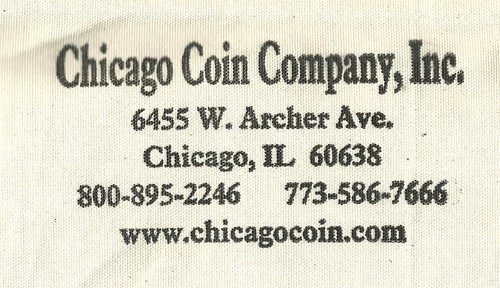
 I also have a cookie tin given out by the Chicago Coin Company about ten years ago. It is about ten inches in diameter and a bit too wide for my scanner. An image is attached. I think this is appropriate for the season. So far, this is the only numismatic cookie tin in my collection.
I also have a cookie tin given out by the Chicago Coin Company about ten years ago. It is about ten inches in diameter and a bit too wide for my scanner. An image is attached. I think this is appropriate for the season. So far, this is the only numismatic cookie tin in my collection.
To read the earlier article, see:
EARLY COIN DEALER PHONE NUMBERS
(www.coinbooks.org/esylum_v16n52a07.html)
OPTICAL ILLUSIONS ON COINS AND MEDALS

Last week an article illustrated the above Philistian drachm which, when turned 90˚ the lion on the coin’s reverse becomes the helmet of the bearded man, and its paws becomes the man’s hair. I asked readers for examples of other examples of such “optical trickery” in coins.
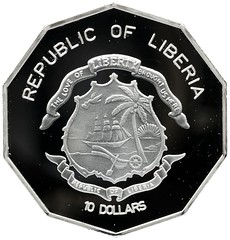 Jay Galst, author of Ophthalmologia Optica et Visio in Nummis writes:
Jay Galst, author of Ophthalmologia Optica et Visio in Nummis writes:
This coin from Liberia 2001, KM # 491, has 2 images on the reverse; rotate by 180 degrees. It is shown in my book: item XI.101. Also, there are some Anti-Papal satirical medals that have 2 images.
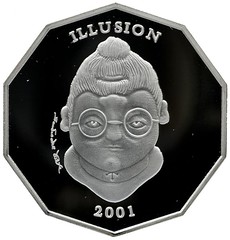
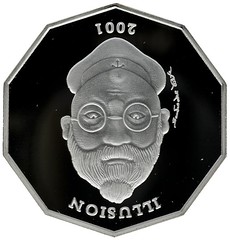
One reverse, two images
To read the earlier E-Sylum article, see: ISRAEL MUSEUM ACQUIRES WORLD’S ‘FIRST JEWISH COIN’ (www.coinbooks.org/esylum_v16n52a20.html)
THE BOOK BAZARRE
NUMISMATIC VOCABULARY: ANAGLYPTOGRAPHY PART 2

ANA - GLYPTA -WHAT? -- PART 2.
The illustration of the Second U.S. Mint appearing in last week's E-Sylum (discussed in Roger Burdette's excellent Journal of Numismatic Research of the engraving in Eckert and Dubois 1842 book) is from a medallion engraving as Roger describes.
The process is called anaglyptography. I have discussed this earlier in
I have written extensively on this subject. The entry on this runs about 1,850 words in my Encyclopedia of Coin and Medal Technology. It is a method of making engravings -- or printer's plates -- from a coin or medal serving as a pattern by a device that Christian Gobrecht invented as a 29-year old watchmaker..
Trouble is -- it was in use for a very brief time (1831-1861). It was replaced by halftone printing plates made from photographs for the most part.
It is still not understood by most numismatic writers, however. Since it is called "medal engraving machine" or "medallion engraving machine" it is thought by some numismatists to engrave the dies not the printer's plates. One of these machines was illustrated in a recent book on tokens and medals.
The anaglyptic process reproduces line engravings of the modulated relief of a coin, medal, seal or cameo -- herewith called an anaglypt - but does not engrave the dies for striking these.
To read the earlier E-Sylum articles, see:
A couple weeks ago Tom Kays asked:
In what year did Washington City, the original twenty mile square diamond shaped, “District of Columbia” lose all the land in Virginia, including Arlington and portions of Alexandria? Eric showed a neat example of a Washington City bank note from a Virginia town.
Eric Schena writes:
The event in 1846 that returned Alexandria County (which was renamed Arlington County in 1920) and the City of Alexandria was called "retrocession."
There are D.C. obsoletes that specified that they would be redeemed in Virginia bank notes, but not the other way 'round. Virginia had a reputation as having a strong and secure banking system, whereas D.C. did not. So, some D.C. banks would specify redemption in Virginia notes to encourage their acceptance.
Now, there were several notes issued in Alexandria while it was part of D.C. (like that 25¢ scrip from the War of 1812 period), but that may be a few dozen issuers at most. Some of the banks opened in Alexandria while a part of D.C. rechartered themselves after retrocession under a different name (the Potomac Bank comes to mind: it became a branch of the Exchange Bank of Virginia). This is why I love our local numismatic history, it's not straightforward!
To read the earlier E-Sylum article, see:
TOM KAYS' NUMISMATIC DIARY: DECEMBER 15, 2013
(www.coinbooks.org/esylum_v16n51a20.html)
Dennis Tucker writes:
David Gladfelter writes:
Better known is the turkey on the Washington Market Exchange civil war token, Fuld NY630CC.
If this keeps going there will soon be material for a book on the topic.
Greg Adams writes:
I've attached a list of 60 National Park medals that Medallic Art Co still sells (at parks and via their web site.
Check out the reverse of the Great Smokey Mt medal.
These medals were first issued in silver in 1972 as a limited edition of 36 medals. Medallic Art then added six more silver medals for a total of 42. Later they used the same dies to make bronze medals and added a number of additional parks for a total of 60. I have a complete sets in both Silver (42) and Bronze (60).
To visit the Medallic Art National Parks page, see:
medallic.com/store/national_park.html
To read the earlier E-Sylum article, see:
MORE TURKEYS IN NUMISMATICS
(www.coinbooks.org/esylum_v16n52a23.html)
Speaking of topical collecting, Howard Daniel writes:
Bill Mullan of the Washington, DC area has had a coin program for school kids where they learn about world coins and then he gives each of them many coins. His "stash" for the kids literally weighs a ton!
One of his ideas for numismatics is that coins be cataloged in more detail so they can be collected by topic. He believes there will eventually be a world coin database and there should be a field in it to identify the major items in their designs so they can be searched. If there is someone interested in the production of honey, they could search the database and find every coin with a bee on it.
Sooner or later a data bank of coins will be formed which will allow a computer to sort for all coins containing a certain design motif. In order for such a sorting process to be effective all subjects that might become the basis for a topical coin collection must be identified.
The task of preparing such a list is a daunting one because it requires the compiler to be aware of all of the topics that interest coin collectors of today and anticipate subjects that may be of interest tomorrow. Such a listing will be the work of many individuals and will probably have to be revised often.
The attached is a first attempt to form such a list. I have given each motif a two letter abbreviation which will be used to describe each coin by the motifs present in its design. Eventually I hope to assign the appropriate abbreviations to each coin in the WORLD CATALOG OF COINS for purposes of sorting by computer. There should be a code assigned to each area of topical coin collecting in which there are a sufficient number of coins to warrant a code. I am not wise enough to make all those judgments, so I am asking all members reading this notice to check the list to see if it satisfies all of the collecting schemes they use or have heard of. If it does not please let me know.
Since the number of motifs ascribed to each coin should be limited (At present I think the limit will be 5 or 6.) Some rules have to be developed for the use of the codes. In general the most restrictive code should be used. For instance the many coins featuring sailing ships would be coded SS (for Sailing Ship) and would not be further coded BO (for Boat) The code BO is used only when the motif in question does not fall into one of the more restricted codes, For instance the canoe on the Canadian dollar or the raft Kon Tiki on Western Samoa coins.
I can see the same thing happening under Buildings. I have a relatively small number of subgroups identified by their own codes mainly because I am not familiar with many of the buildings that are depicted. I am sure that experts will have to be called upon if there is an attempt to create additional subgroups. Some specialist will have to classify some of the buildings on the coins of Germany and Austria for instance.
Where collecting interests overlap it may be necessary to use a general code as well as a more restrictive code for a single coin. All Olympic coins will have to be identified as such for those collectors specializing in them, but the sport may also have to be identified because a collection of soccer coins, for instance, will contain many coins including some minted for Olympic events. Fine judgments will have to be made to determine if the various competitions presently lumped under Field Events warrant separate codes.
Similarly, the broad classifications under animals need some fine tuning. Should there be a breakdown under birds such as aquatic birds, birds of prey, ratite birds, etc. And under animals - it is now such a huge category - should there be subgroups for primates, ungulates, , felines, canines, (all are mammals) etc. ? What should those categories be?
Coats of arms present a problem because they may be comprised of so many motifs such as animals, birds, mountains, or boats that they may easily excede the 5 or 6 motif limit for a single coin . I am proposing to use a short cut on the Arms for socialist countries. I think they all use a star (Heavenly body), and sheaves of wheat (crop) so I am intending to use a code for such coats of arms and not code them separately for the star, or the wheat. Collectors of these topics will soon discover this and will sort for “SE” to identify the stars or wheat coins they would otherwise miss.
No separate coding is provided to separate coins with stars, moons, or the sun. Is this likely to be a problem?
Codes have been assigned to DATE (DA), Denomination (DE) and EMBLEM (EM) for which I envision no practical use in the coin sorting task. I use these for classifying slides I have taken of some coins, and have recorded them here to assure that the letter combinations are not used for some other motif. Actually it may be necessary to assign some kind of coding to individual denominations like the ECU adopted by the European Common Market countries because I can see that becoming a collecting theme.
Numismatic Description Standard (NUDS)
NUDS is a set of suggested field names for recording numismatic information in a column-oriented database. It is designed to capture information as it currently exists in databases deployed by museums and collectors in "real world" situations. It is flexible in that it can represent objects for which only very generic information is known or objects that have been described in detail. It does not mandate a set of required fields.
A main goal in the design of NUDS is that it capture the distinctive categories of numismatic data that are fundamental to the discipline. Primary among these is the distinction between obverse and reverse. It is extremely important that numismatists be able to search for the occurrence of words or visual motifs on the distinct sides of coins. NUDS also recognizes that the edge of a coin often needs to be separately described. Obverse, reverse, and edge are constituent "parts" of a coin. NUDS can also represent particular concepts that are likewise important to numismatists. The concept "denomination," whether explicitly assigned at the the time of production or identified by later scholars, applies to almost all officially issued coins. It is not a field that appears in many museum collection systems. Likewise, "axis" - or the orientation of the obverse to the reverse - is important for numismatic study but not often accounted for in non-numismatic databases.
For more information on Nomisma, see:
nomisma.org
For more information on the Numismatic Description Standard (NUDS), see:
nomisma.org/nuds/numismatic_database_standard
Anne Bentley of the Massachusetts Historical Society writes:
I'm not a bill collector (unintentional pun there) but figure that someone in your readership would be able to answer this gentleman's question...
Happy New Year to you and your readers. All of you have taught me so much about numismatics over the years. Can't think of another hobby with such generous collectors!
Here's the question from Steven M Lind:
I saw a television program that claimed that Santa Claus was on the reverse side of the largest denomination bill ever printed by the US.
Do you know anything about this claim?
Thank you so much for any light you can shed on this.
Anne Bentley adds:
This isn’t numismatic, but on the subject of Santa here’s an 1850’s rumination about his magical powers…
A New England Christmas (And A Mystery)
(www.masshist.org/blog/1014)
To read the earlier E-Sylum articles, see:
Andrew Hurle writes:
Regarding the physical bitcoins illustrated in the last E-Sylum, the Wired article Ring of Bitcoins: Why Your Digital Wallet Belongs On Your Finger
is a good read, and it contains a link to the Casascius website which, by the look of things, has suspended production.
Coindesk.com has a number of interesting articles about physical bitcoins, touching on a couple of subjects which I'm still a little curious about. One is the principle of inflation operating in the production of electronic currency and the other is what it take to destroy electronic currency. When Bitcoin addresses are lost, are the bitcoin values themselves no longer retrievable? Does this mean that those bitcoins are effectively annihilated? I'm not sure. Anyway, I hope the links are useful.
Two weeks ago, Charlie Shrem got hacked and robbed, Bitcoin-style.
Criminals got into a brokerage account used by his transaction services company, Bitinstant, and emptied more than $12,000 worth of the digital currency. Banks can sometimes reel back online transactions and recover the money when it gets stolen by hackers, but Bitcoins don’t work that way. Bitcoins are the digital equivalent of cash, and they can be traded instantly and anonymously. So once they’re gone, they’re gone for good.
Shrem’s hackers made off with a big pile of Bitcoins, but there was a much larger pile — about one-third of Shrem’s total Bitcoin savings — that they couldn’t touch. That’s the pile he keeps on his finger.
About a month ago, Shrem bought a brand new netbook online (from Bitcoinstore, naturally). Without plugging it into the internet, he installed a program called Vanitygen, which generated both a Bitcoin address (a cryptic set of numbers and letters that people could use to give Shrem Bitcoins) and a private key (a longer, cryptic set of numbers and letters needed to give Shrem’s Bitcoins to anyone else).
Well, he engraved most of it into the ring. To add a little extra security, Shrem had his father leave out one of the digits from the private key. That’s stored in Shrem’s head — and only his head.
You see, Shrem — like many other Bitcoin traders — doesn’t trust digital copies of this most digital of currencies. “Even if all of your assets are in Bitcoins, you have to diversify them,” he says. “Twenty percent you should keep on your computer. The rest should be kept in cold storage.”
Cold storage can mean an encrypted USB drive, a computer that is not connected to the internet, a piece of paper, or some other physical medium. Shrem puts his on a ring, but other Bitcoiners are using paper — or even physical coins.
Yes, there’s irony here. Storing the keys to a digital currency on good old-fashioned paper or physical coins seems so very odd at first, but if you’re determined to put your money in Bitcoins, it makes sense.
To read the complete article, see:
Ring of Bitcoins: Why Your Digital Wallet Belongs On Your Finger
(www.wired.com/wiredenterprise/2013/03/bitcoin-ring/)
To visit CoinDesk.com, see:
www.coindesk.com
To read the earlier E-Sylum article, see:
MORE PHYSICAL BITCOINS
(www.coinbooks.org/esylum_v16n52a18.html)
I read the item in last week's issue about the Bank of England switching from paper to polymer.
I am now in Viet Nam and have been using their polymer notes for many years. They had some trouble at first getting the right mixture of ink to adhere to their polymer but they worked it out. Polymer notes do last much longer than paper in the humid tropical climate here.
The "more difficult to fold" is true but once folded, they do not stack well and are trouble in ATMs. Once folded, they are very difficult to completely unfold. The banks here must load their ATMs here with notes with no folds in them. "Slippery when counting" is something new to me but everyone here who counts large numbers of notes also has a counting machine to check their accuracy. The old paper counting machines had to be replaced with new counting machines that can count both paper and polymer. Some of the highest technology counting machines also have counterfeit detection on them, so that is a plus.
The "difficult to counterfeit" is somewhat true but it depends on the money and protection available to the counterfeiter. There is a major polymer counterfeiting operation in southeast China which appears to have legal protection and the money to finance the production of polymer VERY CLOSE to banknote quality. It took a while but the Vietnamese have stopped 99.9% of the notes from that facility coming into Viet Nam. I cannot go into their solution but the Bank of England better make sure they have their own solution to stop the Chinese polymer counterfeits from coming into the United Kingdom! The Chinese do not only counterfeit coins, and they will counterfeit coins and notes of friends and foe!
To read the earlier E-Sylum article, see:
BANK OF ENGLAND TO ISSUE POLYMER BANKNOTE
(www.coinbooks.org/esylum_v16n52a21.html)
Since American money was consolidated into a single system of currency in the late 1800s, U.S. dollars have been printed on a unique cotton blend paper. That paper has been supplied by a single company, Crane, for more than a century. And Crane relied on scraps of denim sold in bulk by the garment industry for its cotton.
The company bleached and processed the unwanted fabric, then rewove the fibers into the George Washingtons and Benjamins that graced our wallets. About 30 percent of Crane's cotton came from leftover denim, making it one of the largest single source of the fibers, according to Jerry Rudd, managing director of global sourcing. The rest of the cotton came from a hodgepodge of other textile wastes.
But something strange began to happen in the 1990s: Denim became tainted.
The stretchy fabric commonly known as spandex (and trademarked as Lycra) had been invented in the 1960s for use in women's lingerie. By the 1990s, the fashion world had discovered that blending it with denim created a curve-hugging -- and yet still forgiving -- fit. It never looked back.
"Everybody's into it. Denim and Lycra are all over," Rudd said. "It's just incredible what's happened to the industry."
The trend was bad news for Crane. Even a single fiber of spandex can ruin a batch of currency paper, degrading the strength of the material. But separating the spandex from the cotton would be a Herculean task, Rudd said. By the early 2000s, almost every pair of jeans contained at least a hint of stretch -- rendering them useless to Crane.
Crane had to adapt. Instead of using cotton from denim, the company now looks "beyond the waste stream," Rudd said, to "the natural fiber itself." In other words, they buy cotton straight from the source and leave the world of fashion to its own devices.
To read the complete article, see:
How tight jeans almost ruined America’s money
(www.washingtonpost.com/blogs/wonkblog/wp/2013/12/16/how-tight-jeans-almost-ruined-americas-money/#!)
One of American track star Jesse Owens’ gold medals from the 1936 Berlin Olympics realized $1,466,574 in an online auction that closed Dec. 8.
Ron Burkle, billionaire investor and co-owner of the Pittsburgh Penguins, purchased the medal, according to SCP Auctions President David Kohler. Burkle, also owner of William Faulkner’s Nobel Prize for Literature medal, has plans for an educational tour for the historic pieces.
Owens earned four gold medals at the Olympic Games, for winning the 100-meter race, the 200-meter race and the long jump, all individually, and as part of the 4x100-meter relay team.
To read the complete article, see:
1936 Olympic gold medal brings $1.4 million
(www.coinworld.com/articles/1936-olympic-gold-medal-brings-1-4-million)
Tom writes:
These continue my Postcards about Money series. These are century old cards with “Fortune” at New Year's as the theme. These come from countries around the world and still beckon from long ago senders wishing that fortune may come to thee (in the form of gold coins) which were then current. I especially like the card with the girl and barrel of money, postmarked on December 30, 1910, as she is wearing a bustle and for some reason, wishes for getting “booty” in 1911 seem doubly apt.
To read the earlier E-Sylum article, see:
POSTCARDS AND NUMISMATICS
(www.coinbooks.org/esylum_v16n51a25.html)
NUMISMATIC VOCABULARY: ANAGLYPTOGRAPHY
(www.coinbooks.org/esylum_v13n48a12.html)
REVIEW: JOURNAL OF NUMISMATIC RESEARCH, SPRING 2013
(www.coinbooks.org/esylum_v16n52a06.html)
QUIZ ANSWER: RETROCESSION
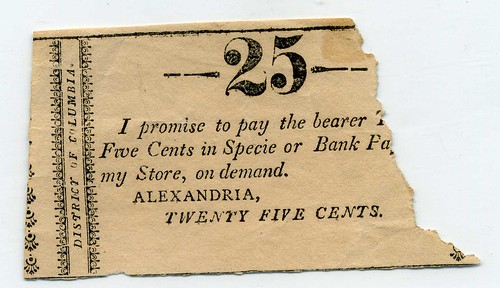
STILL MORE TURKEYS IN NUMISMATICS
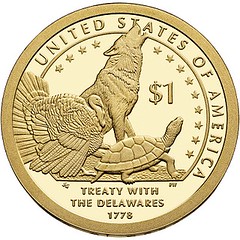 Regarding turkey coins, the 2013 Native American dollar might have already been mentioned. If not, here it is in all its glory. I like it --- an unusual and visually interesting design!
Regarding turkey coins, the 2013 Native American dollar might have already been mentioned. If not, here it is in all its glory. I like it --- an unusual and visually interesting design!
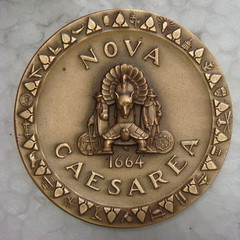 The New Jersey Tercentenary medal of 1964 has a turkey representing the Unalachtigo sub-tribe of the Lenni Lenape, along with many other symbols of the state.
The New Jersey Tercentenary medal of 1964 has a turkey representing the Unalachtigo sub-tribe of the Lenni Lenape, along with many other symbols of the state.
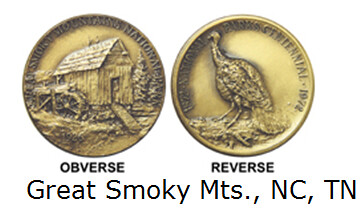
A DATABASE FOR TOPICAL COIN COLLECTORS
Some sort of standard may evolve someday, but it's a daunting task because the field is so vast. How do other fields address this? Is there a cataloging standard for artwork or photographs to "tag" the subject matter elements?
One step in the direction of a common cataloging standard is Nomisma.org, a project organized by Sebastian Heath and Andrew meadows of the American Numismatic Society, along with representatives from other numismatic museums around the world. Associated with Nomisma.org is the Numismatic Description Standard (NUDS).
-Editor
EMPLOYMENT OPPORTUNITY!
Live and Work in Southern California
Stack’s Bowers Galleries offers an important employment opportunity for the right person. We are seeking an experienced numismatist in the American series—coins, tokens, medals, and paper money—to work with our “dream team” of catalogers, building on the tradition of the Ford, Eliasberg, Bass, Cardinal, Norweb, Battle Born and other great collections.
If you can write in an authoritative and compelling manner with a high degree of accuracy, this may be just right for you!
You will be working in Irvine, a modern community in dynamic Orange County, California—one of the finest areas to live. We offer generous benefits including medical and dental coverage, 401K plan, and more. Our offices are in our own modern, state-of-the art building with all amenities.
If you would like to be considered for this position please contact Q. David Bowers by mail or by email with your resumé, samples of your past writing (on numismatics or other subjects), and salary requirements:
Mail to the attention of Q. David Bowers, PO Box 1804, Wolfeboro, NH 03894. Email to:
Ckarstedt@stacksbowers.com
QUERY: SANTA CLAUS ON A LARGE DENOMINATION U.S. BILL

MERRY CHRISTMAS: SANTA CLAUS ON PAPER MONEY
(www.coinbooks.org/esylum_v11n51a14.html)
THERE IS NO SANTA CLAUS IN NUMISMATICS
(www.coinbooks.org/esylum_v15n53a25.html)
THE "LAZY THREE" SANTA CLAUS NOTE
(www.coinbooks.org/esylum_v15n53a26.html)
WHY YOUR DIGITAL WALLET BELONGS ON YOUR FINGER
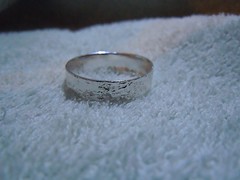 Then Shrem asked his father, a jeweler, engrave the private key on a ring. Yes, a physical ring he could slip onto his finger. “I took the key, and I literally called my father and said it to him over the phone,” Shrem remembers. “He wrote it down on a piece of paper. In his factory here in New York City, he has a jewelry engraver. He took a piece of silver, and he engraved it into a ring.”
Then Shrem asked his father, a jeweler, engrave the private key on a ring. Yes, a physical ring he could slip onto his finger. “I took the key, and I literally called my father and said it to him over the phone,” Shrem remembers. “He wrote it down on a piece of paper. In his factory here in New York City, he has a jewelry engraver. He took a piece of silver, and he engraved it into a ring.”
HOWARD DANIEL ON POLYMER BANKNOTES
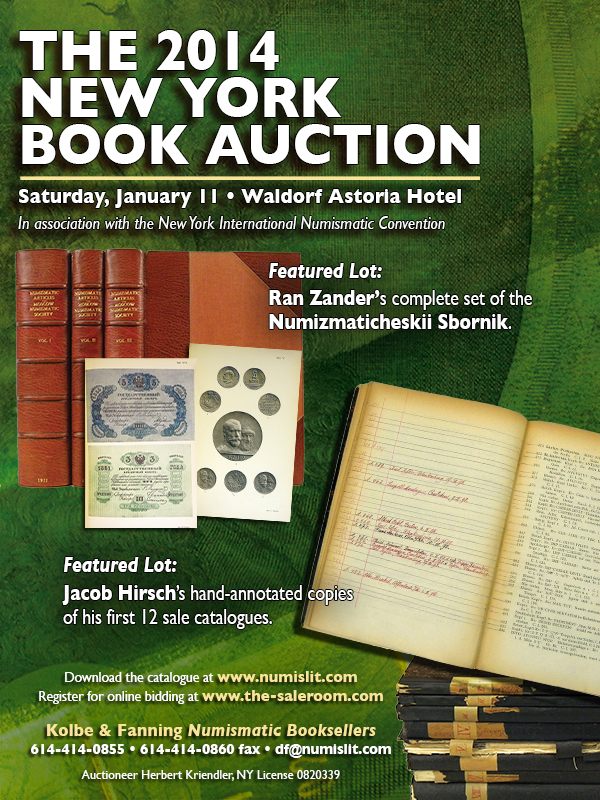
HOW TIGHT JEANS ALMOST RUINED AMERICA’S PAPER MONEY
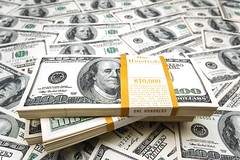 Fashion comes at a price. But who knew that it would claim our entire system of money?
Fashion comes at a price. But who knew that it would claim our entire system of money?
EDUCATIONAL TOUR PLANNED FOR HISTORIC MEDALS
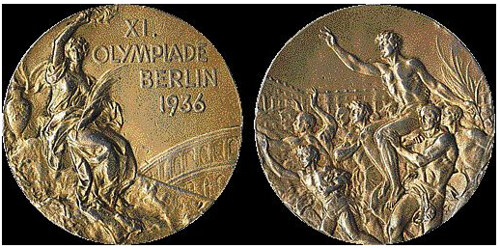
By the way, the same issue of Coin World has a great article by Jeff on numismatic attractions in London. See London Calling on p129.
-Editor
POSTCARDS AND NUMISMATICS: HAPPY NEW YEAR!
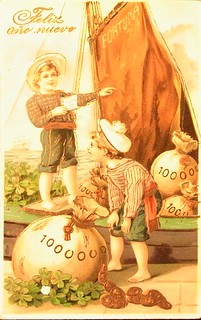
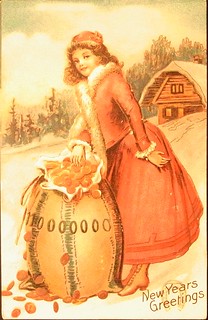
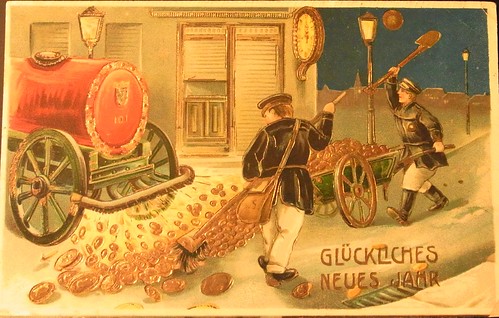
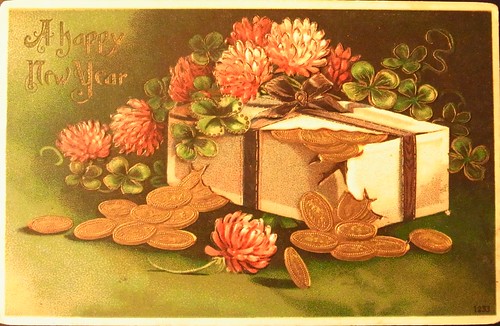
FEATURED WEB SITE: THE E-SYLUM
This week's Featured Web Page is the E-Sylum eNewsletter Archive - 16 volumes of announcements, book reviews, research, news, opinions and chatter about numismatics and numismatic bibliomania.

www.coinbooks.org/club_nbs_esylum_archive.html
